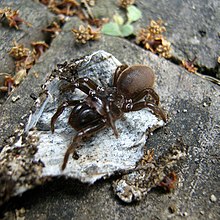Atypus
| Atypus | |
|---|---|

| |
| A. karschi | |
| Scientific classification | |
| Kingdom: | Animalia |
| Phylum: | Arthropoda |
| Subphylum: | Chelicerata |
| Class: | Arachnida |
| Order: | Araneae |
| Infraorder: | Mygalomorphae |
| Family: | Atypidae |
| Genus: | Atypus Latreille, 1804[1] |
| Type species | |
| A. piceus (Sulzer, 1776)
| |
| Species | |
|
34, see text | |
| Synonyms[1] | |
| |
Atypus, also called purseweb spiders, is a genus of atypical tarantulas first described by Pierre André Latreille in 1804.[3] It occurs in Eurasia, with one species (A. affinis) reaching into North Africa, and one species (A. snetsingeri) in the USA. Only three of the described species occur in Europe: A. piceus, A. affinis, and A. muralis.[1]
Peasants in the southern Carpathian Mountains used to cut up tubes built by Atypus and cover wounds with the inner lining. It reportedly facilitated healing, and even connected with the skin. This is believed to be due to antiseptic properties of spider silk (which is made of protein).[4]
Identification features[]
They are three-clawed, medium to large spiders with eight eyes. They have six spinnerets with the median spinneret truncated. The prolateral sides of the maxillae are elongated. The cephalic side of the cephalothorax is elevated. They have large chelicerae with long and thin fangs. The male sternum has marginal ridges.[5]
Species[]
As of April 2019 it contains thirty-four species:[1]
- Atypus affinis Eichwald, 1830 – Europe (Ireland to Ukraine), North Africa
- Hu, 1994 – China
- Li, Xu, Zhang, Liu, Zhang & Li, 2018 – China (Hainan)
- Kim, 1985 – Korea
- Thorell, 1897 – Myanmar, Thailand
- Zhu, Zhang, Song & Qu, 2006 – China
- Kayashima, 1943 – Taiwan
- Zhang, 1985 – China
- Thorell, 1890 – Indonesia (Java)
- Li, Xu, Zhang, Liu, Zhang & Li, 2018 – China (Hainan)
- Atypus karschi Dönitz, 1887 – China, Taiwan, Japan
- Schwendinger, 1989 – Thailand
- Zhu, Zhang, Song & Qu, 2006 – China
- Zhu, Zhang, Song & Qu, 2006 – China
- Namkung, 1986 – Russia (Far East), Korea
- Oliger, 1999 – Russia (Far East)
- Lee, Lee, Yoo & Kim, 2015 – Korea
- Atypus muralis Bertkau, 1890 – Central Europe to Iran and Turkmenistan
- Zhu, Zhang, Song & Qu, 2006 – China
- Atypus piceus (Sulzer, 1776) (type) – Europe (France to Russia), Iran
- Namkung, 2002 – Korea
- Zhu, Zhang, Song & Qu, 2006 – China
- Kim, Ye & Noh, 2015 – Korea
- Schenkel, 1953 – China
- Atypus snetsingeri Sarno, 1973 – USA
- Kim, Kim, Jung & Lee, 2006 – Korea
- Zhang, 1985 – China
- Schwendinger, 1989 – Thailand
- Chennappaiya, 1935 – India
- Kim, Kim, Jung & Lee, 2006 – Korea
- Zhu, Zhang, Song & Qu, 2006 – China
- Tanikawa, 2006 – Japan
- Siliwal, Kumar & Raven, 2014 – India
- Zhu, Zhang, Song & Qu, 2006 – China
References[]
- ^ Jump up to: a b c d "Gen. Atypus Latreille, 1804". World Spider Catalog Version 20.0. Natural History Museum Bern. 2019. doi:10.24436/2. Retrieved 2019-05-16.
- ^ Kraus, O.; Baur, H. (1974). "Die Atypidae der West-Paläarktis: Systematik, Verbreitung und Biologie (Arach. : Araneae)". Abhandlungen und Verhandlungen des Naturwissenschaftlichen Vereins in Hamburg (N.F.). 17: 88.
- ^ Latreille, P. A. (1804). "Tableau methodique des Insectes". Nouveau Dictionnaire d'Histoire Naturelle, Paris. 24: 129–295.
- ^ Heimer, Stefan (1988). Wunderbare Welt der Spinnen (in German). Urania. p. 14. ISBN 3332002104.
- ^ Sebastin, P.A.; Peter, K.V., eds. (2009). Spiders of India. Universities Press. ISBN 978-81-7371-641-6.
- Atypidae
- Mygalomorphae genera
- Spiders of Asia
- Spiders of Africa
- Spiders of North America
- Taxa named by Pierre André Latreille